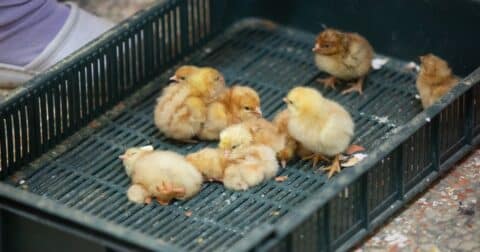Perspective
Critics Declared Veganism Dead in 2025. Here’s What Those Obituaries Are Missing.
Food•5 min read
Explainer
It’s more profitable to grind up billions of baby chicks than it is to raise them for meat.


Words by Seth Millstein
Every year, six billion newborn chicks are killed at egg-laying facilities around the world. Usually, they’re either gassed or shredded to death en masse. These aren’t accidental killings, but rather, an established practice in the egg industry known as “chick culling.” Despite a nonbinding pledge to end the practice by 2020, U.S. egg producers still cull, or kill, 300 million chicks a year as a standard operating procedure.
So, why is chick culling still a thing, and when — if ever — will it end?
When a chicken egg hatches, there’s a roughly 50 percent chance that the chick inside will be male. In the meat industry, this is no problem, because male and female chickens can both be raised as “broilers,” or chickens slaughtered for meat. But in the egg industry, male chicks are a problem.
Up until the early 20th century, U.S. farmers used “dual purpose” chicken breeds for both egg-laying and meat. This changed around the 1920s, when farmers began selectively breeding chickens for one purpose or another. Now, 100 years later, the hens at egg-laying facilities have been bred to pump out as many eggs as possible in their lifetimes, while the chickens at meat facilities have been bred to grow fat as quickly as possible.
Thanks to selective breeding, male chicks that are born at egg-laying facilities will not grow to be especially fat, and the quality of their meat will be poor. But as living creatures, they still require food, water and resources to survive, and all of those things cost farmers money — more money than they’d get from selling the chickens for meat.
The financial calculus, though macabre, is clear: it’s cheaper to kill male chicks after birth than to raise them as broilers. And that’s exactly what farmers at egg-laying facilities do.
In the U.S. and Canada, the most common method of chick-culling is maceration — that is, grinding the chicks to death en masse. Chicks are also culled via gassing, suffocation and electrocution.
In 2016, the industry trade group United Egg Producers (UEP) issued a non-binding pledge to phase out chick culling by 2020. That obviously hasn’t happened, but the group says it remains committed to doing so in the future. If and when the industry does finally move away from chick culling, what might that look like?
Right now, the most popular and viable alternative to chick culling is something called in-ovo sexing. This is the practice of determining the sex of a chicken embryo before the egg hatches, so that eggs with male chicken embryos can be used as animal feed before they’re hatched.
While this technology is still in its infancy, it’s become increasingly popular among European egg producers, in part because several European countries have banned chick culling. Although it has yet to be introduced to the U.S. egg market, at least two companies have committed to using in ovo sexing, one by October of this year.
There are a lot of different in-ovo sexing technologies — around 11 of them, according to a recent review of scientific literature and patents. Some involve drilling a small hole in a newly-laid egg, extracting and testing a fluid sample, and then sealing the hole with beeswax or another substance; other in-ovo sexing technologies are non-invasive, and only require the egg to be optically scanned to determine the sex of the embryo.
Another potential solution to chick culling is gene editing. In recent years, there have been several efforts to create a genetically modified breed of chicken that only lays eggs with female embryos, which would theoretically solve the problem of chick culling entirely. The Israeli company Huminn claims to have accomplished something very close to this.
Huminn’s “Golda hens,” as it refers to them, lay eggs that react differently to blue light depending on the gender of the embryo. If it’s a female, the egg develops normally, but if it’s a male embryo, the blue light halts its development entirely. As such, no male chicks are born, or culled, from Golda hens.
Lastly, there’s a decidedly old-school solution to the problem of chick culling, which is to stop using different breeds of chicken for meat and egg-laying.
For most of agricultural history, this was the norm. Male chickens were eaten, and female chickens were kept around to lay eggs (and then eaten). But over the course of the 20th century, producers selectively bred chickens at an aggressive rate in order to maximize both egg and meat production. As a result, some chicken breeds now lay an unnatural amount of eggs, while others grow to be unnaturally large; the former are used as layers, while the latter are used for meat.
While this specialized breeding is more efficient and profitable for egg producers, it’s also the reason chick culling exists. If farms reverted back to the historical standard, and used dual-purpose chickens like the Rhode Island Red for both eggs and meat, chick culling would be a thing of the past.
Some are. Sort of. In Europe, many egg producers have embraced in-ovo sexing. The largest hatchery in Europe began using in-ovo technology in 2021, and a September 2023 analysis found that 15 percent of egg-laying hens in the European Union were sexed in-ovo. The technology has been implemented in several more European countries since then.
In the U.S, however, in-ovo sexing technology isn’t yet being used. Why?
As of this writing, chick culling is banned in Austria, France, Germany and Luxembourg. Italy has banned the practice as well, though it doesn’t take effect until the end of 2026, and Switzerland has banned the grinding, but not the gassing, of male chicks.
In the U.S., by contrast, chick culling is fully legal. While there are technological and financial challenges to adopting in-ovo sexing, the lack of any legal pressure to do so is undoubtedly a huge reason for its lack of progress as well.
In 2021, United Egg Producers said in a press release that, while it’s still committed to phasing out chick culling, the technology used in Europe isn’t ready to be launched in the U.S., as it doesn’t satisfy: “food safety, ethical standards and a scalable solution.”
Respeggt is one of the companies that has developed in-ovo sexing technology, and its system has been in use at the largest hatchery in Norway for the last year. Over the course of that year, the company’s technology sexed about 20 million eggs in Norway and German. That’s a relatively small fraction of the approximately 600 million eggs that need to be sexed every year in the United States in order to keep up with current rates of egg consumption.
In addition to scaling issues, in-ovo technology also faces a question of timing. The goal of ending male chick culling — at least, from an animal welfare perspective — is to prevent the pain and suffering chicks feel when they’re killed. In order to do this, however, egg producers need to be able to identify the sex of an embryo before that embryo is capable of feeling pain.
This is where things get tricky, because there’s no consensus yet on the question of when exactly a chicken embryo can feel pain. Some studies put the number at seven days after hatching, while others suggest that it’s closer to 13 days.
That discrepancy matters a lot. If the 13-day estimate is correct, Respeggt’s in-ovo tech is potentially a great way to reduce pain, as it can detect the sex of a chick between eight and 11 days after it’s hatched. But if the seven-day estimate is the accurate one, Respeggt’s technology won’t be able to save any chicken embryos from feeling pain.
That said, since many male chicks are ground up alive, it’s probably still a less painful death than they’d experience if they were born and culled.
As mentioned earlier, switching to dual-purpose chicken breeds would eliminate the perceived necessity of chick culling. But it would also result in fewer eggs and less chicken meat being produced, as dual-purpose breeds are less efficient than specialized ones. Supply would go down, but without any corresponding drop in demand, poultry prices would increase significantly.
At its current state, in-ovo sexing would also result in pricier eggs, though probably only by a couple of pennies.
Despite the slow progress, there’s still hope that U.S. egg producers will eventually follow Europe’s lead and phase out chick culling.
John Brunnquell is the founder and president of Egg Innovations, a company that sells free-range and pasture-raised chicken eggs. In March, Brunnquell told the New York Times that the main hatchery he uses is set to start using in-ovo sexing technology in early 2025, and will hopefully be selling cull-free eggs later that summer.
It’s unclear which form of in-ovo sexing technology that hatchery will be using, and Brunnquell declined to identify the hatchery, citing a non-disclosure agreement.
In May of this year, the Dutch egg producer Kipster announced a commitment to use in-ovo sexing in its Indiana egg operation by October.
Ultimately, the reason most of the egg industry still cull chicks is because it’s legal and more profitable than the alternatives. Animal rights activists have called for a ban on chick culling in the U.S. to no avail. Some animal protection groups, including The Humane League, have been working to persuade brands like Kipster to adopt alternative methods.
The key to getting the rest of the U.S. egg industry on board is to ensure methods like in-ovo sexing are just as profitable as the alternative. Thankfully, there are signs that this is happening. The price of sexing chicks in-ovo has dropped steadily over the last five years, and if cull-free eggs are able to achieve price parity with the competition, male chicks may soon be spared the fate that so many of them face every day.